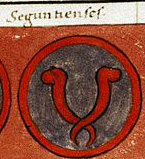Crossed Serpents of Segontium (from the Notitia Dignitatum)
In past blog articles I've explored the "true identity" of Uther Pendragon from many angles. There are only a handful of viable candidates. However, as I'm now fairly certain that Arthur was, indeed, Ceredig son of Cunedda (at least all of my extensive research to date strongly indicates that this is true!), I thought we might look once more at the possibility that Uther was Cunedda, rather than being Ambrosius.
As I see it, once we accept Uther [Pen]Dragon as a title (and not all scholars do so), we have only four possible candidates for this personage:
1) Ambrosius
2) Vortigern (who in the "Gwarchan Maeldderw" is possessor of the Red Dragon)
3) St. Illtud
4) Cunedda
Readers by now are familiar with my arguments for and against Vortigern (chronologically impossible, if nothing else; P.C. Bartram estimates his birth date as 365 A.D.) and St. Illtud. The latter looked especially promising early on, as he bears Latin military ranks or descriptors that are very close to the Welsh Uther [Pen]dragon. Alas, I could not account for the name Arthur in the context of a scenario in which Illtud was his father. Arthur is Latin/Roman Artorius and is a decknamen for an Irish Artri or British Arthr(h)i, 'Bear-king.' The name or title was given to Ceredig because his original center of power appears to have been a headland fort at Aberarth, the mouth of the Afon Arth or Bear River. Proof that this river was of vital - and probably religious - importance to the ruling family of Ceredigion is found in the bear-names among its early princes.
Ambrosius, as I've taken great pains to show, is an anachronistic figure, based on the 4th century Praetorian Prefect of Gaul and his son, St. Ambrose. These figures, in turn, were conflated with the god Lleu and then with the Northern Myrddin. Needless to say, this was not Arthur's father, either.
Cunedda's date is right; his "migration" to Wales is now generally dated to the 5th century (see John T. Koch's CELTIC CULTURE: A HISTORICAL ENCYCLOPEDIA).
When I think about Cunedda, the first question that comes to mind is this: although mentioned, along with his sons, in the HISTORIA BRITTONUM, why is there no inclusion of him in the Dinas Emrys story, where all of western Wales is given by Vortigern to Ambrosius? And why, once we reach the pages of Geoffrey of Monmouth's HISTORY OF THE KINGS OF BRITAIN, is Cunedda reduced to the wholly fictional king Cunedagius?
Well, I can hazard a guess: as I've been able to conclusively prove, Cunedda was Irish, not British. So instead of having Vortigern give all of western Britain to the Irish, which is what actually happened, it was thought preferable to give that region to the "last of the Romans", i.e. Ambrosius.
This is aptly demonstrated by the tradition that records Cadwallon Lawhir, grandson of Cunedda, driving the Irish from Arfon - where Dinas Emrys is located. We know the Laigin left their name in the Lleyn Peninsula and at Dinllaen. Cunedda and his sons were Ciannachta, so it quite plausible this tribal group eventually took the rest of western Wales from other Irish.
Given the association of not only Ambrosius with Dinas Emrys, but Uther Pendragon as well (see my previous identification of Brittany/Llydaw with Llyn Llydaw near the fort), we might logically ask whether the Terrible Chief-Dragon given western Wales by Vortigern was, in fact, Cunedda. After all, the Cunorix son of Maquicoline found buried at Viroconium in Powys was a son of Cunedda, and Vortigern ruled from Powys.
The "Marwnad Cunedda" tells us Cunedda was the dread of his enemies, and the serpents/dragons of Dinas Emrys may owe their origin to the crossed serpent standard of Segontium. Early warriors or kings of Gwynedd are referred to in heroic terms as snakes or dragons. Could it be that the real Terrible Chief-Dragon of Dinas Emrys was not Emrys, but instead Cunedda? Or, possibly, an Irish chieftain who held Arfon prior to its conquest by the immediate descendants of Cunedda?
I will soon have Koch's edition and translation of the 'Death-Song of Cunedda.' Perhaps further study of that poem will allow me to make more conclusive statements regarding the equation of Uther with Cunedda. For now I will only say that Ambrosius at Dinas Emrys must be dispensed with, and an Irish presence substituted for him there.

No comments:
Post a Comment
Note: Only a member of this blog may post a comment.